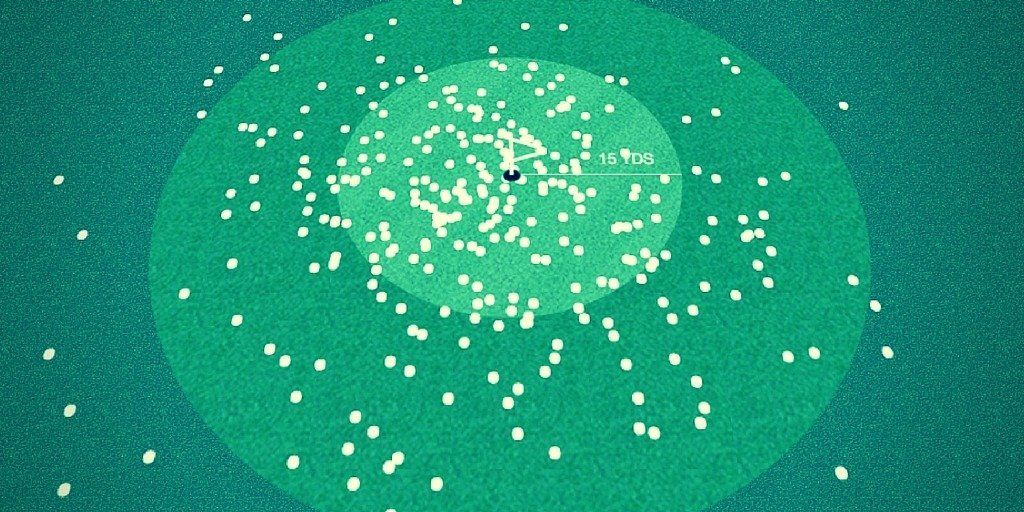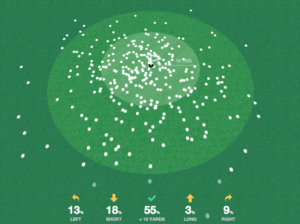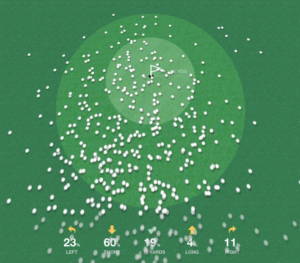
There’s nothing worse than hitting an iron shot perfectly, and watching it sail over the green.
I’ve developed a fear of this scenario that is completely irrational, and I think there are plenty of other golfers who suffer from the same thing.
I’m afraid that I’m going to hit the ball over the green, and it’s starting to affect my club selection on the course.
There’s no truth to it
The problem with this fear is that it’s completely unfounded.
When I spoke to GAME GOLF CEO John McGuire a few months back, the first thing I asked him was what was the biggest revelation the company had figured out after analyzing millions of golf shots. I knew what I wanted him to say, and thankfully he confirmed my suspicions.
He said that 94% of golfers consistently leave their approach shots short of the green.
That is really an insane statistic when you think about it. I believe there are a number of reasons why this is happening:
1) We don’t strike the ball as well on the golf course as we do in our practice sessions
2) Golfers love to believe that they hit the ball farther than they do
3) We don’t have the right yardage information (get a GPS or Rangefinder!)
However, I believe that the fear of hitting the ball over the green is also a large part of this. I’ve logged almost 25 rounds with GAME GOLF so far, so I have a pretty good understanding of what’s currently going on with my game. I took a look at my approach shots outside of 100 yards to see what my trends were.

Only 3% of my shots were long, and 18% were coming up short. Overall, I’m pretty happy with these numbers. Most of the time I am choosing the right club, but ultimately in the back of my mind I make that decision with the desire of not flying the ball over the green. I think this is contributing to me missing more greens on the shorter side (in addition to mishits).
So if I do take more club on average, it’s likely that I’ll start hitting more greens, and possibly hit a few shots over the green.
Now let’s take a look at another golfer’s stats. This is from a player who has an 18 handicap.

You can see that this golfer is missing 60% of their shots short of the green, and only 4% long.
Overall, this golfer is hitting 19% of their greens during their round. To me this is low-hanging fruit in how they can improve their scores. I believe just my choosing more club into the green, this player will be able to eliminate a couple of shots per round.
While this is just one example, the bulk of the data collected has shown that this is an issue at all levels of play, and generally it will plague higher-handicap golfers even more.
It’s not a terribly complicated concept once you have the stats in front of you, which is why I advocate using a game-tracking system like GAME GOLF (you can snag the original version for $125 right now). When you're presented with the information about your game, it's easier to figure out where you can make changes. Many times they will be easy to implement.
Why Using More Club Makes Sense
Most golf course architects place most of the trouble (bunkers generally) short of the green because they understand all of this, and have for quite some time.
Certain holes will feature trouble behind the green, and in those situations a smart course manager would try to make sure they avoid that possibility. However, if you think about most of the holes on the courses you play, you’ll see that trouble is generally on the short side of the green.
It’s not a coincidence, trust me.
Course management is my favorite topic in golf because I think a golfer’s strategy is one of the most important determining factors in the types of scores they are going to shoot, which is exactly why I wrote my eBook on the topic. We get so obsessed with our swings, but the fact remains that you can make a perfect swing and still get a bad result because you didn’t think about your target, and what is surrounding it.
So the next time you are hemming and hawing between a 6-iron and 7-iron, maybe you should choose the 6-iron. There are two scenarios that make the 6-iron the smarter choice:
1) You are not Ben Hogan, and there’s a distinct possibility you will not hit the 7-iron perfectly.
2) Taking the 6-iron will probably give you a better chance of landing on the green AND avoiding the trouble to the short side. If you go over the green, and it’s just some grass back there, it’s not the end of the world.
I haven’t been following my own advice on this topic, and it’s time to start listening to what the data is telling me about my game.
We care about the protection of your data Read our Privacy Policy